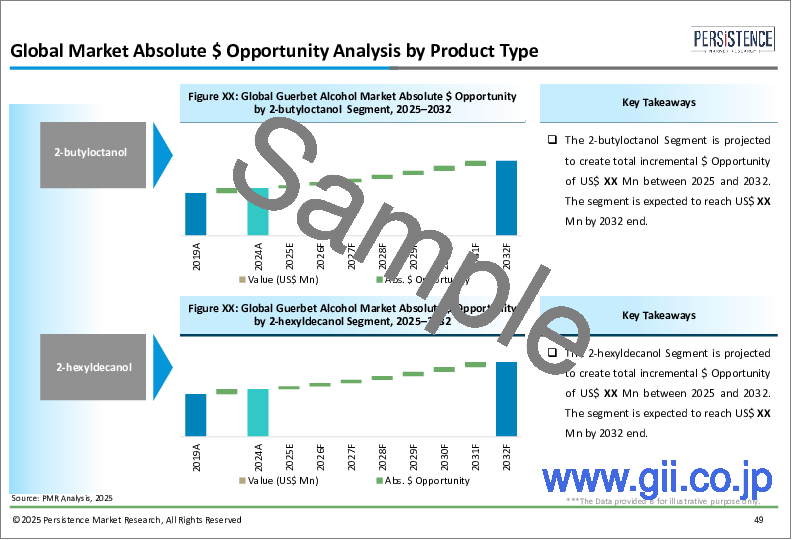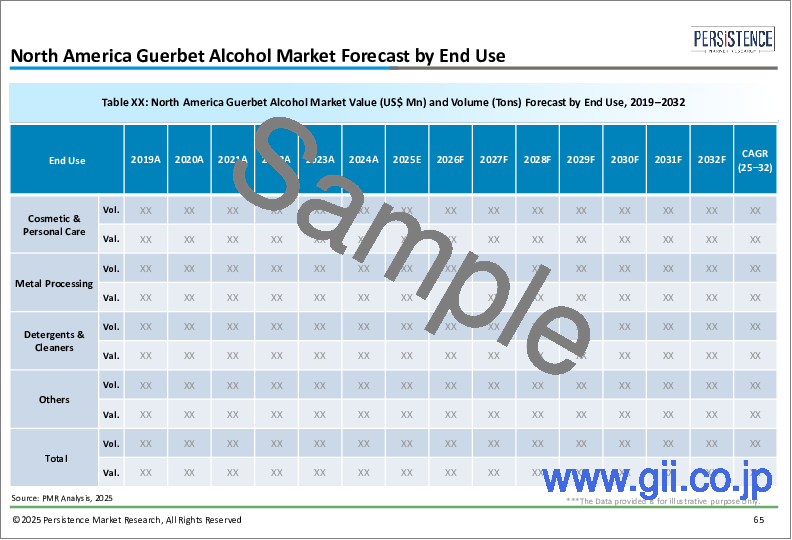|
|
市場調査レポート
商品コード
1697151
ゲルベアルコールの世界市場:業界分析、規模、シェア、成長、動向、予測(2025年~2032年)Guerbet Alcohols Market: Global Industry Analysis, Size, Share, Growth, Trends, and Forecast, 2025 - 2032 |
||||||
カスタマイズ可能
|
|||||||
| ゲルベアルコールの世界市場:業界分析、規模、シェア、成長、動向、予測(2025年~2032年) |
|
出版日: 2025年04月04日
発行: Persistence Market Research
ページ情報: 英文 189 Pages
納期: 2~5営業日
|
全表示
- 概要
- 目次
世界のゲルベアルコールの市場規模は、2025年に13億6,240万米ドルになるとみられ、2025年~2032年の予測期間に4.8%のCAGRで拡大し、2032年には18億9,160万米ドルに達すると予測されています。
ゲルベアルコールは、その優れた展延性、エモリエント性、潤滑性により、パーソナルケア、化粧品、潤滑剤、医薬品用途に広く使用されている高分子分岐アルコールです。これらのアルコールは、スキンケア製品、化粧品、工業用潤滑油の処方において重要な役割を果たしています。市場成長の原動力となっているのは、高級化粧品処方、バイオベースの潤滑剤、持続可能な化学成分に対する需要の増加です。ゲルベアルコールは可塑剤、洗剤、コーティング剤にも使用され、産業用途をさらに拡大しています。
ゲルベアルコールの世界市場は、スキンケアやパーソナルケア製品における高性能エモリエント剤の需要の高まりなど、いくつかの重要な要因に後押しされています。化粧品や産業用途において、バイオベースで持続可能な化学物質へのシフトが進んでいることが、市場の成長をさらに後押ししています。さらに、高品質な潤滑剤や溶剤に対する工業用需要の増加は、化学合成技術の進歩と相まって、生産効率と製品供給力を高めています。製薬セクターの拡大と、医薬品製剤における特殊成分のニーズの高まりも、市場成長に寄与しています。
有望な成長が見込まれますが、分岐アルコールの生産コストの高さ、規制の枠組みの厳しさ、代替エモリエント剤や潤滑剤との競合といった課題に直面しています。複雑な合成プロセスと特殊な原料が必要なため、サプライチェーンの制約や価格変動が生じる可能性があります。さらに、化粧品や潤滑剤に安価な代替品が利用できるようになると、特に価格に敏感な地域では市場拡大の妨げになる可能性があります。
ゲルベアルコール市場は、持続可能で環境に優しい成分に対する消費者の需要の高まりによって、大きな成長機会をもたらしています。グリーンケミストリーの革新に向けた研究開発への投資が増加することで、よりコスト効率が高く、環境に優しい生産方法が実現する可能性があります。さらに、生分解性潤滑油や特殊コーティング剤などの新たな用途でゲルベアルコールの使用が拡大していることも、市場拡大の新たな道を提供しています。化学メーカーとパーソナルケアブランドの共同開発による新規処方の開発は、成長をさらに促進すると思われます。
当レポートでは、世界のゲルベアルコール市場について調査し、製品タイプ別、最終用途別、地域別動向、および市場に参入する企業のプロファイルなどを提供しています。
目次
第1章 エグゼクティブサマリー
第2章 市場概要
第3章 主要な市場動向
第4章 重要成功要因
第5章 世界市場の需要分析:2019年~2032年
- 過去の市場規模(トン)分析、2019年~2024年
- 現在および将来の市場規模(トン)予測、2025年~2032年
- 前年比成長動向分析
第6章 世界市場- 価格分析
- 価格の内訳
第7章 世界市場の需要(金額または規模、100万米ドル)分析:2019年~2032年
- 過去の市場金額分析、2019年~2024年
- 現在および将来の市場金額予測、2025年~2032年
第8章 市場背景
第9章 世界市場分析:製品タイプ別、2019年~2032年
- イントロダクション
- 市場規模と数量分析、製品タイプ別、2019年~2024年
- 現在および将来の市場規模と数量分析および予測、製品タイプ別、2025年~2032年
- 2-ブチルオクタノール
- 2-ヘキシルデカノール
- 2-オクチルドデカノール
- 2-デシルテトラデカノール
- 2-ドデシルヘキサデカノール
- その他
- 製品タイプ別の市場の魅力分析
第10章 世界市場分析:最終用途別、2019年~2032年
- イントロダクション
- 市場規模と数量分析、最終用途別、2019年~2024年
- 現在および将来の市場規模と数量分析および予測、最終用途別、2025年~2032年
- 化粧品・パーソナルケア
- 金属加工
- 洗剤・クリーナー
- その他
- 最終用途別の市場の魅力分析
第11章 世界市場分析:地域別、2019年~2032年
- イントロダクション
- 市場規模と数量分析、地域別、2019年~2024年
- 現在および将来の市場規模と数量分析および予測、地域別、2025年~2032年
- 北米
- ラテンアメリカ
- 欧州
- 東アジア
- 南アジアと太平洋
- 中東・アフリカ
- 地域別の市場の魅力分析
第12章 北米市場分析:2019年~2032年
第13章 ラテンアメリカ市場分析:2019年~2032年
第14章 欧州市場分析:2019年~2032年
第15章 東アジア市場分析:2019年~2032年
第16章 南アジア・太平洋市場分析:2019年~2032年
第17章 中東・アフリカ市場分析:2019年~2032年
第18章 市場構造分析
第19章 競合分析
- 競合ダッシュボード
- 競合の詳細
- BASF SE
- Sasol Ltd.
- New Japan Chemical Co., Ltd
- Kao Corporation
- Kisco Ltd.
- Kokyu Alcohol Kogyo Co., Ltd
- DowPol Corporation
- Jarchem Industries
- EMCO DYESTUFF P.LTD
第20章 前提と使用される頭字語
第21章 調査手法
Persistence Market Research has recently released a comprehensive report on the worldwide market for Guerbet alcohol. The report offers a thorough assessment of crucial market dynamics, including drivers, trends, opportunities, and challenges, providing detailed insights into the market structure. This research publication presents exclusive data and statistics outlining the anticipated growth trajectory of the global Guerbet alcohol market from 2025 to 2032.
Key Insights:
- Guerbet Alcohol Market Size (2025E): USD 1,362.4 Million
- Projected Market Value (2032F): USD 1,891.6 Million
- Global Market Growth Rate (CAGR 2025 to 2032): 4.8%
Guerbet Alcohol Market -
Report Scope:
Guerbet alcohols are high-molecular-weight branched alcohols widely used in personal care, cosmetics, lubricants, and pharmaceutical applications due to their excellent spreading, emollient, and lubricating properties. These alcohols play a critical role in the formulation of skincare products, makeup, and industrial lubricants. The market growth is driven by increasing demand for premium cosmetic formulations, bio-based lubricants, and sustainable chemical ingredients. Guerbet alcohols are also used in plasticizers, detergents, and coatings, further expanding their industrial applications.
Market Growth Drivers:
The global Guerbet alcohol market is propelled by several key factors, including the rising demand for high-performance emollients in skincare and personal care products. The growing shift towards bio-based and sustainable chemicals in cosmetics and industrial applications further fuels market growth. Additionally, increasing industrial demand for high-quality lubricants and solvents, coupled with advancements in chemical synthesis technology, enhances production efficiency and product availability. The expansion of the pharmaceutical sector and the rising need for specialized ingredients in drug formulations also contribute to market growth.
Market Restraints:
Despite promising growth prospects, the Guerbet alcohol market faces challenges related to the high production cost of branched alcohols, stringent regulatory frameworks, and competition from alternative emollients and lubricants. The complex synthesis process and the requirement for specialized raw materials may lead to supply chain constraints and price fluctuations. Additionally, the availability of cheaper substitutes in cosmetics and lubricants could hinder market expansion, especially in price-sensitive regions.
Market Opportunities:
The Guerbet alcohol market presents significant growth opportunities driven by rising consumer demand for sustainable and eco-friendly ingredients. Increasing investments in research and development for green chemistry innovations can lead to more cost-effective and environmentally friendly production methods. Furthermore, the expanding use of Guerbet alcohols in emerging applications, such as biodegradable lubricants and specialty coatings, provides new avenues for market expansion. Collaborations between chemical manufacturers and personal care brands to develop novel formulations will further drive growth.
Key Questions Answered in the Report:
- What are the primary factors driving the growth of the Guerbet alcohol market globally?
- Which applications are contributing to the increasing demand for Guerbet alcohols?
- How are technological advancements shaping the production of Guerbet alcohols?
- Who are the key players in the Guerbet alcohol market, and what strategies are they adopting?
- What are the emerging trends and future prospects in the global Guerbet alcohol market?
Competitive Intelligence and Business Strategy:
Leading players in the global Guerbet alcohol market, including BASF SE, Sasol Limited, and Evonik Industries AG, focus on innovation, product differentiation, and sustainability to gain a competitive edge. These companies invest in research and development to enhance production efficiency and expand their product portfolios. Strategic partnerships with cosmetic and lubricant manufacturers, as well as advancements in bio-based production processes, further strengthen their market position. Additionally, initiatives promoting eco-friendly and biodegradable formulations support long-term market sustainability.
Key Companies Profiled:
- BASF SE
- Sasol Limited
- Kao Corporation
- New Japan Chemical Company Ltd.
- DowPol Corporation
- Kokyu Alcohol Kogyo Co., Ltd.
- KISCO Ltd.
- Jarchem Industries, Inc.
- EMCO dyestuff
Key Segments Covered in Market Research
By Product Type
- 2-butyloctanol
- 2-hexyldecanol
- 2-octyldodecanol
- 2-decyltetradecanol
- 2-dodecylhexadecanol
- Others
By End User
- Cosmetic and Personal Care
- Metal Processing
- Detergents and Cleaners
- Others
By Region
- North America
- Latin America
- Europe
- East Asia
- South Asia and Pacific
- Middle East and Africa
Table of Contents
1. Executive Summary
- 1.1. Global Market Outlook
- 1.2. Demand Side Trends
- 1.3. Supply Side Trends
2. Market Overview
- 2.1. Market Taxonomy
- 2.2. Market Definition
3. Key Market Trends
- 3.1. Key Trends Impacting the Market
4. Key Success Factors
5. Global Market Demand Analysis 2019-2032
- 5.1. Historical Market Volume (Tons) Analysis, 2019-2024
- 5.2. Current and Future Market Volume (Tons) Projections, 2025-2032
- 5.3. Y-o-Y Growth Trend Analysis
6. Global Market - Pricing Analysis
- 6.1. Pricing Break-up
- 6.1.1. Manufacturer Level Pricing
- 6.1.2. Distributor Level Pricing
7. Global Market Demand (in Value or Size in US$ Mn) Analysis 2019-2032
- 7.1. Historical Market Value (US$ Mn) Analysis, 2019-2024
- 7.2. Current and Future Market Value (US$ Mn) Projections, 2025-2032
- 7.2.1. Y-o-Y Growth Trend Analysis
- 7.2.2. Absolute $ Opportunity Analysis
8. Market Background
- 8.1. Macro-Economic Factors
- 8.2. Forecast Factors - Relevance and Impact
- 8.3. Value Chain Analysis
- 8.4. Market Dynamics
- 8.4.1. Supply Chain
- 8.4.2. Drivers
- 8.4.3. Restraints
- 8.4.4. Opportunity Analysis
9. Global Market Analysis 2019-2032, by Product Type
- 9.1. Introduction
- 9.2. Historical Market Size (US$ Mn) and Volume Analysis By Material, 2019-2024
- 9.3. Current and Future Market Size (US$ Mn) and Volume Analysis and Forecast By Product Type, 2025-2032
- 9.3.1. 2-butyloctanol
- 9.3.2. 2-hexyldecanol
- 9.3.3. 2-octyldodecanol
- 9.3.4. 2-decyltetradecanol
- 9.3.5. 2-dodecylhexadecanol
- 9.3.6. Others
- 9.4. Market Attractiveness Analysis By Product Type
10. Global Market Analysis 2019-2032, by End Use
- 10.1. Introduction
- 10.2. Historical Market Size (US$ Mn) and Volume Analysis By Material, 2019-2024
- 10.3. Current and Future Market Size (US$ Mn) and Volume Analysis and Forecast By End Use, 2025-2032
- 10.4. Cosmetic and Personal Care
- 10.5. Metal Processing
- 10.6. Detergents and Cleaners
- 10.7. Others
- 10.8. Market Attractiveness Analysis By Product Type
11. Global Market Analysis 2019-2032, by Region
- 11.1. Introduction
- 11.2. Historical Market Size (US$ Mn) and Volume Analysis By Material, 2019-2024
- 11.3. Current and Future Market Size (US$ Mn) and Volume Analysis and Forecast By End Use, 2025-2032
- 11.3.1. North America
- 11.3.2. Latin America
- 11.3.3. Europe
- 11.3.4. East Asia
- 11.3.5. South Asia and Pacific
- 11.3.6. Middle East and Africa
- 11.4. Market Attractiveness Analysis By Region
12. North America Market Analysis 2019-2032
- 12.1. Introduction
- 12.2. Pricing Analysis
- 12.3. Historical Market Size (US$ Mn) and Volume Trend Analysis By Market Taxonomy, 2019-2024
- 12.4. Market Size (US$ Mn) and Volume Forecast By Market Taxonomy, 2019-2032
- 12.4.1. By Country
- 12.4.1.1. U.S.
- 12.4.1.2. Canada
- 12.4.2. By End Use
- 12.4.3. By Product Type
- 12.4.1. By Country
- 12.5. Market Attractiveness Analysis
- 12.5.1. By Country
- 12.5.2. By End Use
- 12.5.3. By Product Type
- 12.6. Key Market Participants - Intensity Mapping
- 12.7. Drivers and Restraints - Impact Analysis
13. Latin America Market Analysis 2019-2032
- 13.1. Introduction
- 13.2. Pricing Analysis
- 13.3. Historical Market Size (US$ Mn) and Volume Trend Analysis By Market Taxonomy, 2019-2024
- 13.4. Market Size (US$ Mn) and Volume Forecast By Market Taxonomy, 2019-2032
- 13.4.1. By Country
- 13.4.1.1. Brazil
- 13.4.1.2. Mexico
- 13.4.1.3. Rest of Latin America
- 13.4.2. By End Use
- 13.4.3. By Product Type
- 13.4.1. By Country
- 13.5. Market Attractiveness Analysis
- 13.5.1. By Country
- 13.5.2. By End Use
- 13.5.3. By Product Type
- 13.6. Key Market Participants - Intensity Mapping
- 13.7. Drivers and Restraints - Impact Analysis
14. Europe Market Analysis 2019-2032
- 14.1. Introduction
- 14.2. Pricing Analysis
- 14.3. Historical Market Size (US$ Mn) and Volume Trend Analysis By Market Taxonomy, 2019-2024
- 14.4. Market Size (US$ Mn) and Volume Forecast By Market Taxonomy, 2019-2032
- 14.4.1. By Country
- 14.4.1.1. Germany
- 14.4.1.2. Italy
- 14.4.1.3. France
- 14.4.1.4. U.K.
- 14.4.1.5. Spain
- 14.4.1.6. BENELUX
- 14.4.1.7. Russia
- 14.4.1.8. Rest of Europe
- 14.4.2. By End Use
- 14.4.3. By Product Type
- 14.4.1. By Country
- 14.5. Market Attractiveness Analysis
- 14.5.1. By Country
- 14.5.2. By End Use
- 14.5.3. By Product Type
- 14.6. Key Market Participants - Intensity Mapping
- 14.7. Drivers and Restraints - Impact Analysis
15. East Asia Market Analysis 2019-2032
- 15.1. Introduction
- 15.2. Pricing Analysis
- 15.3. Historical Market Size (US$ Mn) and Volume Trend Analysis By Market Taxonomy, 2019-2024
- 15.4. Market Size (US$ Mn) and Volume Forecast By Market Taxonomy, 2019-2032
- 15.4.1. By Country
- 15.4.1.1. South Korea
- 15.4.1.2. China
- 15.4.1.3. Japan
- 15.4.2. By End Use
- 15.4.3. By Product Type
- 15.4.1. By Country
- 15.5. Market Attractiveness Analysis
- 15.5.1. By Country
- 15.5.2. By End Use
- 15.5.3. By Product Type
- 15.6. Key Market Participants - Intensity Mapping
- 15.7. Drivers and Restraints - Impact Analysis
16. South Asia and Pacific Market Analysis 2019-2032
- 16.1. Introduction
- 16.2. Pricing Analysis
- 16.3. Historical Market Size (US$ Mn) and Volume Trend Analysis By Market Taxonomy, 2019-2024
- 16.4. Market Size (US$ Mn) and Volume Forecast By Market Taxonomy, 2019-2032
- 16.4.1. By Country
- 16.4.1.1. India
- 16.4.1.2. ASEAN
- 16.4.1.3. ANZ
- 16.4.1.4. Rest of SAP
- 16.4.2. By End Use
- 16.4.3. By Product Type
- 16.4.1. By Country
- 16.5. Market Attractiveness Analysis
- 16.5.1. By Country
- 16.5.2. By End Use
- 16.5.3. By Product Type
- 16.6. Key Market Participants - Intensity Mapping
- 16.7. Drivers and Restraints - Impact Analysis
17. Middle East and Africa Market Analysis 2019-2032
- 17.1. Introduction
- 17.2. Pricing Analysis
- 17.3. Historical Market Size (US$ Mn) and Volume Trend Analysis By Market Taxonomy, 2019-2024
- 17.4. Market Size (US$ Mn) and Volume Forecast By Market Taxonomy, 2019-2032
- 17.4.1. By Country
- 17.4.1.1. Gulf Co-operation Council Countries
- 17.4.1.2. Turkey
- 17.4.1.3. Northern Africa
- 17.4.1.4. South Africa
- 17.4.1.5. Rest of Middle East and Africa
- 17.4.2. By End Use
- 17.4.3. By Product Type
- 17.4.1. By Country
- 17.5. Market Attractiveness Analysis
- 17.5.1. By Country
- 17.5.2. By End Use
- 17.5.3. By Product Type
- 17.6. Key Market Participants - Intensity Mapping
- 17.7. Drivers and Restraints - Impact Analysis
18. Market Structure Analysis
- 18.1. Market Analysis by Tier of Companies
- 18.2. Market Concentration
- 18.3. Market Share Analysis of Top Players
- 18.4. Market Presence Analysis
- 18.4.1. By Regional footprint of Players
- 18.4.2. Product foot print by Players
- 18.4.3. Channel Foot Print by Players
19. Competition Analysis
- 19.1. Competition Dashboard
- 19.2. Competition Deep Dive
- 19.2.1. BASF SE
- 19.2.1.1. Overview
- 19.2.1.2. Product Portfolio
- 19.2.1.3. Profitability by Market Segments (Product/Channel/Region)
- 19.2.1.4. Sales Footprint
- 19.2.1.5. Strategy Overview
- 19.2.1.5.1. Marketing Strategy
- 19.2.1.5.2. Product Strategy
- 19.2.1.5.3. Channel Strategy
- 19.2.2. Sasol Ltd.
- 19.2.2.1. Overview
- 19.2.2.2. Product Portfolio
- 19.2.2.3. Profitability by Market Segments (Product/Channel/Region)
- 19.2.2.4. Sales Footprint
- 19.2.2.5. Strategy Overview
- 19.2.2.5.1. Marketing Strategy
- 19.2.2.5.2. Product Strategy
- 19.2.2.5.3. Channel Strategy
- 19.2.3. New Japan Chemical Co., Ltd
- 19.2.3.1. Overview
- 19.2.3.2. Product Portfolio
- 19.2.3.3. Profitability by Market Segments (Product/Channel/Region)
- 19.2.3.4. Sales Footprint
- 19.2.3.5. Strategy Overview
- 19.2.3.5.1. Marketing Strategy
- 19.2.3.5.2. Product Strategy
- 19.2.3.5.3. Channel Strategy
- 19.2.4. Kao Corporation
- 19.2.4.1. Overview
- 19.2.4.2. Product Portfolio
- 19.2.4.3. Profitability by Market Segments (Product/Channel/Region)
- 19.2.4.4. Sales Footprint
- 19.2.4.5. Strategy Overview
- 19.2.4.5.1. Marketing Strategy
- 19.2.4.5.2. Product Strategy
- 19.2.4.5.3. Channel Strategy
- 19.2.5. Kisco Ltd.
- 19.2.5.1. Overview
- 19.2.5.2. Product Portfolio
- 19.2.5.3. Profitability by Market Segments (Product/Channel/Region)
- 19.2.5.4. Sales Footprint
- 19.2.5.5. Strategy Overview
- 19.2.5.5.1. Marketing Strategy
- 19.2.5.5.2. Product Strategy
- 19.2.5.5.3. Channel Strategy
- 19.2.6. Kokyu Alcohol Kogyo Co., Ltd
- 19.2.6.1. Overview
- 19.2.6.2. Product Portfolio
- 19.2.6.3. Profitability by Market Segments (Product/Channel/Region)
- 19.2.6.4. Sales Footprint
- 19.2.6.5. Strategy Overview
- 19.2.6.5.1. Marketing Strategy
- 19.2.6.5.2. Product Strategy
- 19.2.6.5.3. Channel Strategy
- 19.2.7. DowPol Corporation
- 19.2.7.1. Overview
- 19.2.7.2. Product Portfolio
- 19.2.7.3. Profitability by Market Segments (Product/Channel/Region)
- 19.2.7.4. Sales Footprint
- 19.2.7.5. Strategy Overview
- 19.2.7.5.1. Marketing Strategy
- 19.2.7.5.2. Product Strategy
- 19.2.7.5.3. Channel Strategy
- 19.2.8. Jarchem Industries
- 19.2.8.1. Overview
- 19.2.8.2. Product Portfolio
- 19.2.8.3. Profitability by Market Segments (Product/Channel/Region)
- 19.2.8.4. Sales Footprint
- 19.2.8.5. Strategy Overview
- 19.2.8.5.1. Marketing Strategy
- 19.2.8.5.2. Product Strategy
- 19.2.8.5.3. Channel Strategy
- 19.2.9. EMCO DYESTUFF P.LTD
- 19.2.9.1. Overview
- 19.2.9.2. Product Portfolio
- 19.2.9.3. Profitability by Market Segments (Product/Channel/Region)
- 19.2.9.4. Sales Footprint
- 19.2.9.5. Strategy Overview
- 19.2.9.5.1. Marketing Strategy
- 19.2.9.5.2. Product Strategy
- 19.2.9.5.3. Channel Strategy
- 19.2.1. BASF SE






